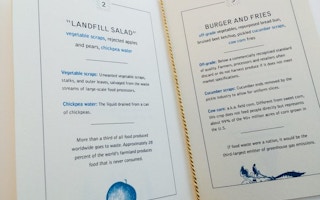When the United Nations hosted a high-level lunch for visiting world leaders at the UN dining room during the General Assembly sessions last September, they were in for an unexpected surprise.
The lunch, hosted by Secretary-General Ban Ki-moon, a strong advocate of “zero hunger”, consisted largely of recycled food salvaged from the kitchen before it was dumped into garbage bins.
“Every dish was made from scraps that would normally be wasted,” Ban told another group of world leaders at a dinner on the sidelines of the World Economic Forum (WEF) in Davos last week.
One of the appetizers was called “landfill salad,” he said, singling it out as “a small example of sustainable solution” to eliminating world hunger.
Ban, who will be completing his 10-year tenure at the United Nations end December, is vociferously campaigning for the total eradication of extreme hunger by 2030 under the UN’s new Sustainable Development Goals (SDGs), adopted by world leaders last September.
Ban said more than a third of the world’s food goes to waste. And “eliminating wasted food in homes and in fields is a key element in achieving Zero Hunger.”
”The United Nations,” he declared,” is ready to lead new, large-scale initiatives to end hunger,” and practice in its own backyard – and in its own kitchen– what it is preaching to the rest of the world.
Danielle Nierenberg, President and co-founder of Washington-based Food Tank, told IPS the issue of food waste is very hot right now among foodies and environmentalists alike.
“Unfortunately, food waste continues to be an issue that not enough scientists, researchers, farmers, businesses, policymakers, and funders and investors, as well as eaters like you and me, don’t know or care about enough.”
“And it is part of our job is to help change that by highlighting some of the innovations and solutions that are happening on the ground, in fields, boardrooms, kitchens, grocery stores, restaurants classrooms, and laboratories around the country, as well as town halls and the halls of Congress”, she noted.
Currently up to 40 per cent of the food produced in the United States is wasted. That’s enough food to fill a 90,000-person stadium every day. And globally, roughly 1.3 billion tons of food is wasted per year.
At the same time, said Nierenberg, at least 1 in 6 Americans are unsure of where the next meal will come from, and more than 800 million people worldwide are hungry.
In the developing world, pests, disease, and a lack of infrastructure to store and transport crops prevent food from reaching markets or the tables of the needy; in the industrialized world, retailers and consumers waste an equal amount by throwing food away.
But food waste isn’t just a moral conundrum. It’s also an environmental problem. Food waste represents about 5 per cent of all greenhouse gas (GHG) emissions in the United States and 25 per cent of all water use, she noted.
Ban told the gathering in Davos: “We recently heard from aid workers who arrived in Madaya in Syria who told us people there are gaunt and fragile from such severe hunger. One family traded their car for three kilos of rice. “
Tragically, he said, this desperation is mirrored in other crises around the world. “We have a responsibility to answer the cries of people’s right to food.”
Nierenberg told IPS the good news is that the solutions for reducing food loss and waste can be surprisingly simple, inexpensive, and business-friendly.
Moreover, they can simultaneously decrease hunger, poverty, and agriculture’s carbon footprint. And youth leadership, creative solutions to food waste, and entrepreneurial development are emerging as effective ways to fight food loss and waste.
“I think some of the most exciting innovations are coming from groups like Feedback, who helped organize the lunch at the United Nations last year, are making sure that policymakers, farmers, eaters, and the funding and donor communities all realize that they have a role to play in preventing food loss and waste”.
And there are so many exciting business opportunities for small scale cooling and storage, redistribution of food that would have otherwise been wasted, and other businesses that can help both farmers and eaters prevent loss and waste.
“I think this is also an issue that will need a lot of North to South and South to North information sharing and is an opportunity for farmers and businesses all over the world to learn from one another,” she added.
Although farmers in the developing world experience different challenges regarding storage and cooling than farmers in the industrialized world, they both have to deal with unrealistic cosmetic standards that often farmers to throw away imperfect looking, but perfectly nutritious and edible produce.
Ugly produce is one of the biggest opportunities for both small and big farmers alike because they can use these ugly vegetable and fruits to make value added products and increase incomes and nutrition, she declared.










